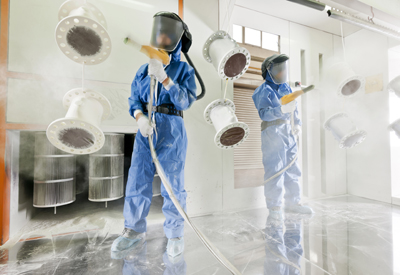Coatings
 A number of coatings exist for your operations. To achieve the best coating and reduce your waste and emissions, evaluate the coating you are using against alternative coatings.
A number of coatings exist for your operations. To achieve the best coating and reduce your waste and emissions, evaluate the coating you are using against alternative coatings.
Organic Solvent-based
This is the traditional type of painting material, typically containing about 40 percent solids with a relatively high organic-solvent content. While this coating material is one of the most versatile, its low solids content and high percentage of solvent carrier can cause low overall transfer efficiency. To get the required dry film thickness more material must be sprayed compared to coatings with higher solids content and lower volatile organic compound
(VOC) emissions.
High-solids
This paint type has a higher percentage of paint solids and a lower percentage of solvent carrier. Overall transfer efficiency is usually better than traditional solvent-based paint. The increased solids content means that the application rate can increase or fewer applications are needed to get the required film thickness. Air emissions from the solvent are generally less due to reduced organic solvent content. A paint heater may be required to reduce viscosity. Also, the film thickness is more difficult to control with high solid paints.
Waterbased
These paint types typically have a high solids content, use water as a solvent and have very low or no organic-solvent content. Advantages of these paint types include reduced VOC emissions, reduced fire hazard, minimized or eliminated hazardous waste disposal and easy cleanup. Some companies have so drastically reduced air emissions from painting with waterbased coatings that they no longer need an air emissions permit or need to report releases on the EPA’s Form R reports. Using a waterbased coating may require a cleaner surface, longer drying times, increased oven temperatures and a temperature-controlled paint storage area. The switch to waterbased materials must be done carefully. Waterbased coating technology is the fastest changing in the market today.
Catalyzed or Two-component
These coatings are created by mixing two low-viscosity liquids just before entering the application system. One liquid contains reactive resins, and the other contains a catalyst that promotes resins to polymerize. These coatings eliminate or reduce solvents and cure at low temperatures.
The catalysts and paint components may be hazardous themselves and create a different set of emission and exposure problems than those of organic solvents. Catalyzed painting also means more material may be wasted if pot life is neglected.
Powder Coating
Producing no VOC emissions, hazardous overspray wastes or wastewater sludges, powder coatings are 100 percent resin in dry, powdered form which when cured in an oven produce a high-quality, durable, corrosion-resistant coating. Collecting and reusing dry coating material that does not stick to the part is possible. Reuse allows powder coaters to achieve very high overall transfer efficiencies.
Powder coating requires specialized application equipment using electrostatic charges to apply the material. The substrate must be able to tolerate the oven’s curing temperature (typically 300 to 450° F). Advancements in powder coating formulas are occurring at a rapid pace. New powder coatings are becoming available to meet special manufacturing needs.
Radiation Cured
Ultraviolet (UV), electron beam (EB) and infrared (IR) coatings use electromagnetic radiation to cure. These coatings typically have a lower VOC content than conventional coatings, require smaller ovens and allow for increased production rates due to a shorter curing period. The shape of the part will affect curing—flat surfaces are easiest to cure. Capital investments are higher than for conventional ovens and the cost of the coating material may be higher depending on the application method used and transfer efficiency.
Industry Case Studies
- Streater (pg4). The manufacturer of store fixtures switched to using powder coating and reduced their VOC emissions.